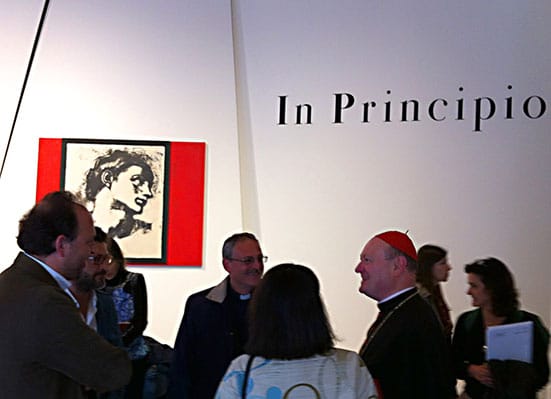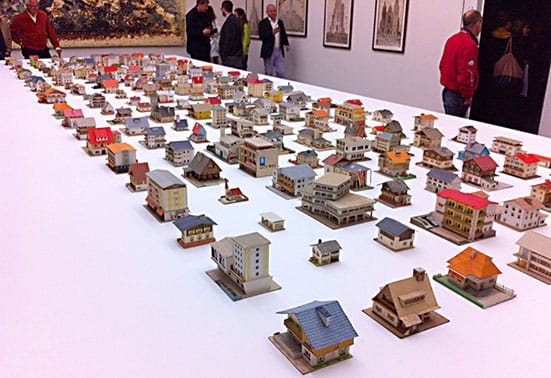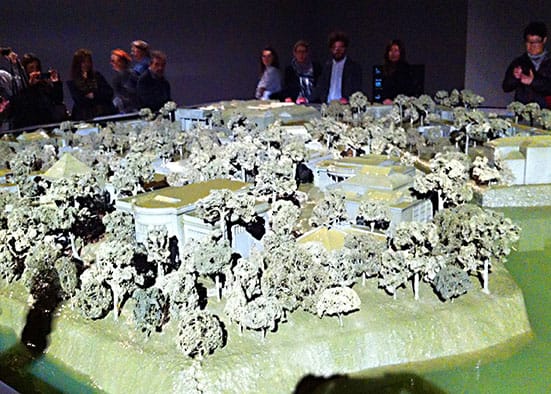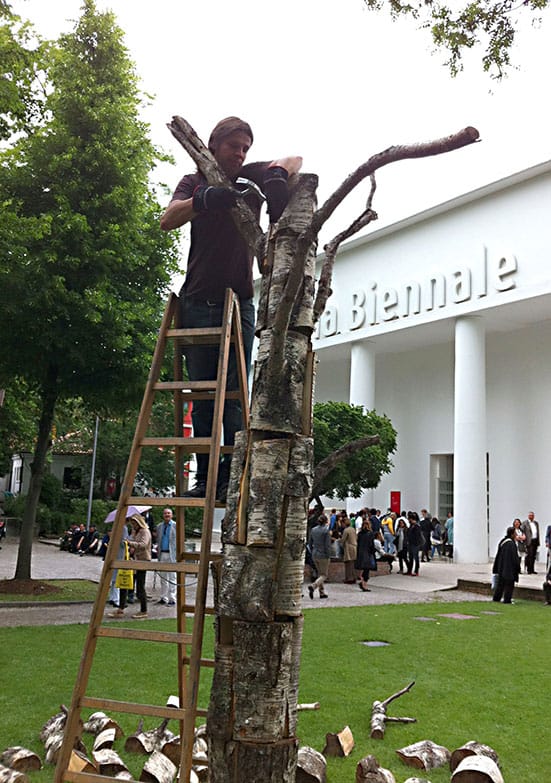Outrageous! Against nature! Such disgusting behaviour! Just not how these things are done, and the slow start of the collapse of civilisation and no doubt heralding the gentle beginning of the cultural apocalypse; huffed and puffed the traditionalists. Ah, said the others, but they’re French…. and they’re very chilled about these things; and the Germans, they’re quite modern too aren’t they? What’s all this about? Kraftwork covering Voulez Vous Coucher Avec Moi Ce Soir ? No, The French and Germans have swapped pavilions down at ye oldie Venice Biennale. Well it wouldn’t be the Americans and Swiss would it?
Mien dieu. Mon Gott. Is this it? The breakdown of the modern thingermy? No, no it’s not. However it re-highlights the anachronism that is the Venice Biennale; with all it national pavilions, and how it is slowly drifting quaintly into the past. However this also sets it apart from all the other biennales, biennials, trinenales and quadrinnales, that every town with an empty sewage-works likes to have these days. Like Eurovision it seems designed for stereotyping and lazy cliché (see above) however it can give something to kick against. Both France and Germany are showing exhibitions by artists that are neither French nor German (Romuald Karmakar, Santu Mofokeng, Dayanita Singh and Ai Weiwei) so really there was no reason to swap except to make the point. Ai Wei Wei’s installation did work well in the ex-French space but this was not the primary reason. This wasn’t a wife-swap, it should be closer to a convenient exchange of holiday homes but it garnered press like limited edition Colombian Haggis.
Meanwhile down the Arsenale…. The Chinese, who have long inhabited a vast, oil-tank-filled space, have spent the last eighteen months forcibly relocating said tanks to lovely new homes. The empty space has then been filled with a load of huge gold rods. The Vatican have got themselves a little space too – perhaps to show that they are keen to engage intelligently in the modern world, and that, despite how they are often perceived, they have an understanding of contemptary culture and the issues of today. Yeah, or ‘praps not: four paintings of Jesus and an under-Pope in a red hat. They could not have looked more out of touch if they had banned menstruating women and made gay people use a different door.
The Arsenale is oddly tidy this time around. A lot of time and money has been spent putting up walls and painting them white. A nu-media piece at either end stood out. Camille Henrot’s hypnotic film with pop-up window after pop-up window layering the screen faster even than my attention could wander, and pitch for an exhibition called The Universal Addressability of Dumb Things, by Mark Leckey. More high-techh, A.D.D. work splicing car ads, computer graphics and selected other moving imagery. Great to see Artvehicle contributor Ed Atkins’s work in there too.
In the centre a Paul McCarthy welcomes you to the Cindy Sherman-curated section. A massive, Muppetty soft toy grins out, with its massive, Muppetty soft tummy ripped open and its massive, Muppetty soft guts hanging out. She’s included collections ofeerie photographs of babies from the nineteenth century, their hiden mothers holding them still. They sit alongside massively blown up photo-portraits of tiny railway figures by Laurie Simmons and Allan McCollum; the lumpen imperfections in the plastic and detailed paintwork of eyes and mouths made life-size and crude. Her secation was the highpoint of the two-mile shed.
Outsider art, the work of driven, un-trained individuals cropped up throughout Venice; Most were dead unfortunately so were unable to attend the opening of their big break; to chat about being discovered and how happy they are to be embraced by the art world; no doubt nodding sagely as queues of bloggers and part-time art tutors told them how jealous they were of the opportunity to work in isolation like that, unhindered by the demands of a contemporary art practice.
There is a great piece in the Central Pavilion; a massive tableau of 387 tiny model buildings. Built by Peter Fritz in the 50s and 60s from scraps of packaging and household objects. They depict small-town detached dwellings that never existed, yet look believable due to their modesty and quietness. They were discovered in 1993 wrapped in black plastic in a junk shop.
More shed art – Alfredo Jaar produced Venezia, Venezia: a 6-metre model of the Giardini that disappears beneath sludge-green lagoon water every few minutes only to rise slowly from the depths again once the water has stilled; the water draining from the roofs and rushing down the hill from the British pavilion before disappearing once again. Good fun this, and quite useful too for working out where things are if you are quick. Could it possibly be making a point about:
The Environment? This was one of the big themes this year. Antti Laitinen down at the Finish pavilion spent three hours doing an elegant performance to accompany his exhibition Falling Trees, where he nailed five trees back together. Using a massive stack of assorted truck sections, forks and branch stumps and some enormous nails he Frankesteined himself a little copse (corpse?); and finished just before it started raining too. Good work.
All this climate change work was elegantly undermined by the Biennale’s free Art Vaparettos to the Giardini, which we were enthusiastically told about when we collected our passes. What a great idea we must use them, where do they come from? We never found out, no one did; up and down the Grand Canal they chugged, totally empty, bar the four people that happened to be standing near its illusive start point.
As we saw in the 80s: crass bling and large labels look tasteless in times of austerity, and here in the big V the limited-edition cloth IT bag appears to have had its day too. This time around it was all about retro bags – Gilbert and George from 2005 stood out and a vintage piece from a little-known Eastern European Biennale was guaranteed to get smug points. Once again the Biennale chose to break with ethical convention and run with a revolting, nylon sack.
Likewise there were rather fewer of the big, swinging yachts we’ve come to expect; even Thatcher’s favourite scum, the bankers decided that perhaps they might leave the Ferrari at home and take the wife’s motor in to the office on Mayday (back when rioting didn’t get you put in a pit for a decade and make your mum homeless).
There were a couple of course, but some of the owners of the biggest slabs of pointless decided to leave them in the bath at home. Oh but why Mr. Abramovich? Why have you chosen not to block out the sun with your huge knob this time around? Is it perhaps cos young Jimmy Deller is taking this opportunity to use the British Pavlion to come over all Mike Leigh/Danny Boyle and let his thoughts be known about the appalling state of things? A massive mural evoked William Morrizilla, and pictured him tossing a pathetic little 163.5-metre boat into the sea. Elsewhere text spoke of the rebellion against tax avoidance that will take place in St. Helier in 2017, and centre stage was A Good Day for Cyclists depicting a hen harrier carrying away a Range Rover – a fantasy act of revenge for Prince Harry and some snooty sidekick supposedly blowing a pair out of the sky for posh jollies last year. Brilliant. Great to see a bit of antiestablishment attitude up on the hill.
Money cropped up elsewhere too. The Greek pavilion had a fascinating entrance hall, with huge texts about alternative money systems through the ages; starting with the conch shell and ending with the bit-coin. Vadim Zakharov’s installation for Russia though, got the prize for using the whole building in one enormous performative, participatory installation all about Danaë, who got impregnated by Zeus. Like a huge Fischer Price garage, gold coins were winched up through the building, dramatically tossed into a machine where they containued their journey to the very pinnacle of the pavilion. From here they tumbled through the space onto a glittering, golden heap. Only women were allowed near this pile and were issued clear umbrellas to keep them safe as they collected more coinage for the machine. Men watched passively from an upper balcony.
Socially the parties were as good as ever, however there was a shift in how best to approach them. Twitter and text meant that word traveled swiftly about location, booze supply and snackage. The result being the danger of leaving a good event for a better one and finding a queue had developed of summoned colleagues. It was safer generally to stay at a well-supplied venue than to chase another, particularly if it was raining. Events worthy of mention were the Slovenian party, in a school gym complete with hula-hoops and pummel horses and the Finland party, which was held in an old theatre with great music. One of the highlights was the launch of the Gothenburg Biennale (opening in September). Another stunning palazzo, music, booze and tiny little canapés – no queue and all our mates ended up there anyway. As a biennale it looks like it will be well worth attending and a Gothenburg 2013 bag may be the one to have on your shoulder at the Venice Biennale in 2015.
Adrian Lee

Jesus (Photo: Adrian Lee)

Peter Fritz (Photo: Adrian Lee)

Alfredo Jaar (Photo: Ali MacGilp)

Antti Laitinen (Photo: Adrian Lee)

Russia (Photo: Adrian Lee)